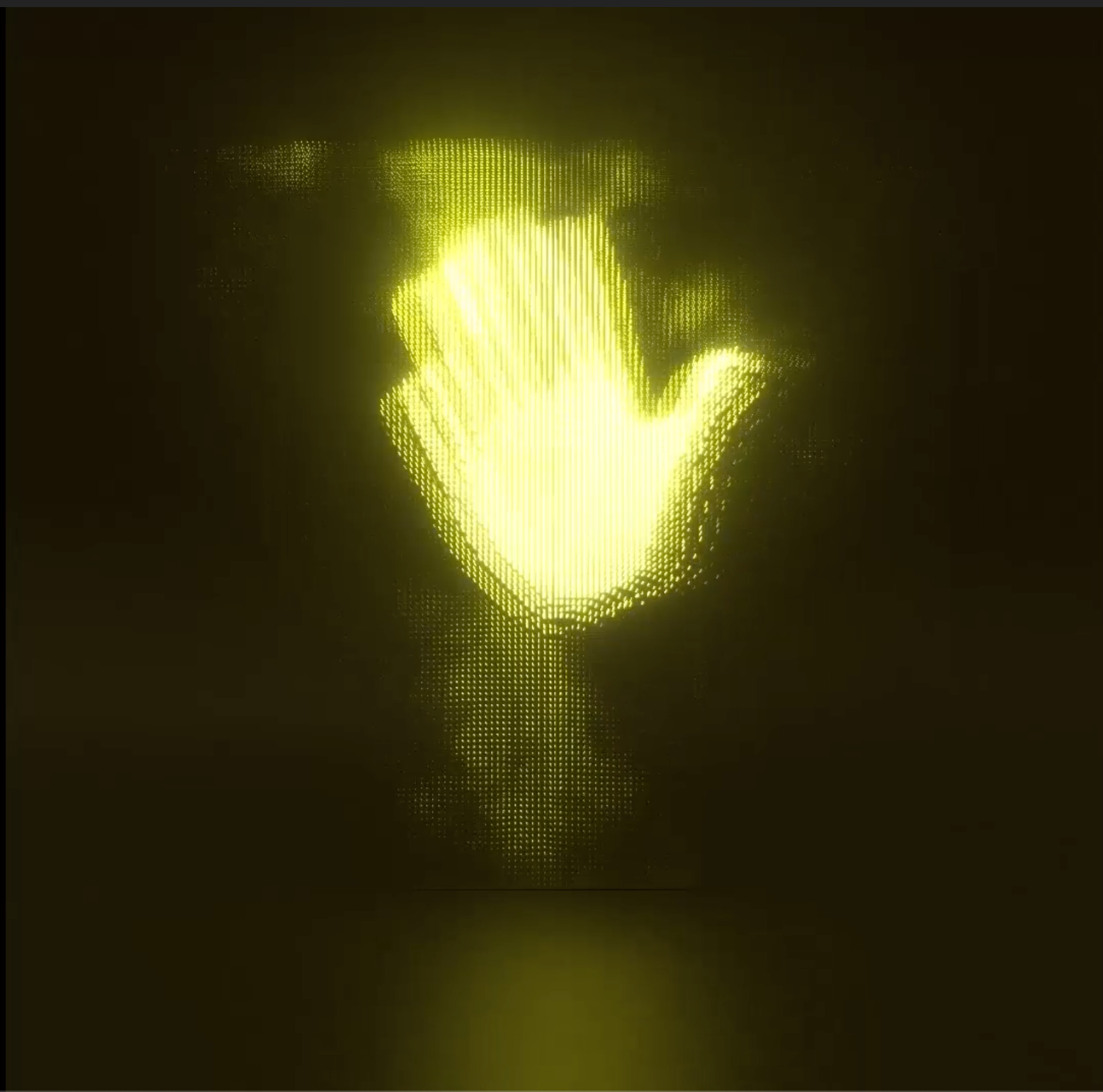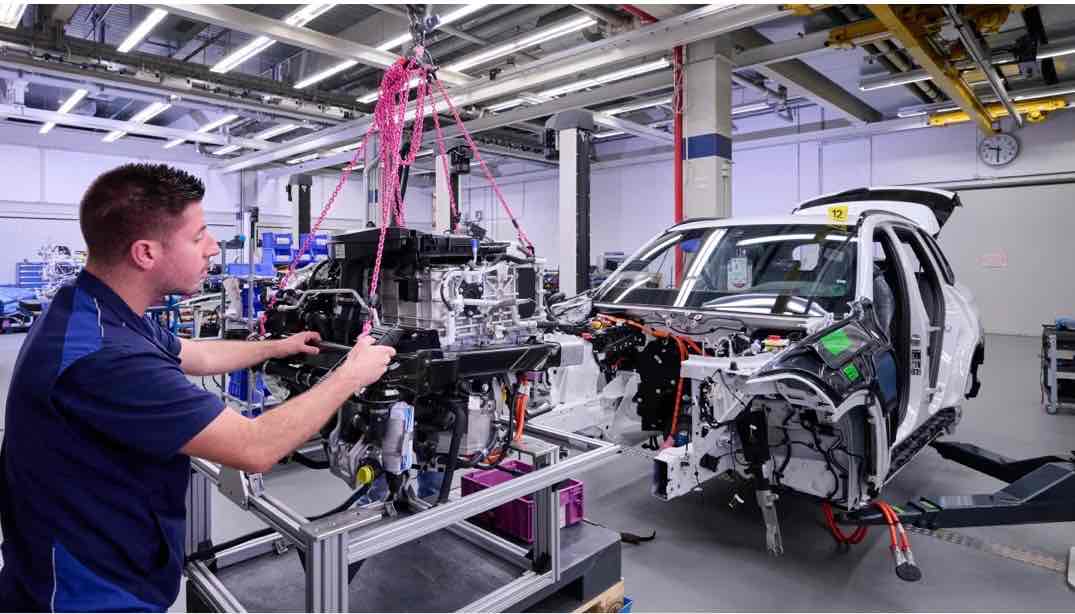BMW Who?
In the era of new energy and intelligent automobiles, the traditional powerhouses BBA seem to have lost their voice and almost been kicked out of China. No one buys Mercedes EQS and EQE, and EQA and EQB together are just a joke. Audi’s 4S shops need to print human-sized fonts to prove that they really have new energy vehicles. What’s the recent news from BMW? i3 price reduction? M2 and XM release? These are not very important. Oliver Zipse, BMW’s CEO, announced at the group meeting on August 3 this year that in January 2023, at the CES show in Las Vegas, BMW will release a concept car that will showcase the design concepts and product features of some new generation models of Neue Klasse. According to Adrian van Hooydonk, the senior VP of BMW’s design department, the new era models will emphasize the uniqueness of each model with strong character, making it instantly recognizable not only as a BMW but also as that particular model.

Figure 1: Screenshot of the “I’M DEE” animation on BMW’s official website (Source: bmw.com)

Figure 2: Screenshot of the “I’M DEE” animation on BMW’s official website (Source: bmw.com)

Figure 3: Screenshot of the “I’M DEE” animation on BMW’s official website (Source: bmw.com)
Recently, a digital animation appeared on BMW’s official website as shown in the above figures. The animation reads “HI, I’M DEE” and “NICE TO MEET YOU”. This is a clear indication that BMW is creating suspense for the CES show to be held in three weeks. I personally guess that DEE will be the name of BMW’s intelligent cockpit voice assistant in the new era. DEE is the abbreviation of the German initials of this voice assistant, such as “Digitale Eigene Experte” (Exclusive Digital Expert) and so on. I made up this full name, so I’m not responsible if it turns out to be true or not. However, “Yo Dee, show me the way to the liquor store” sounds gangster and I like it.# CES 2023: BMW’s Neue Klasse Concept Car
This year’s CES exhibition will be another heavyweight event following the release of BMW’s i8 back in 2014. The i8 launch represented a milestone in BMW’s understanding and engineering capabilities of new energy vehicles. The Neue Klasse concept car, set to be unveiled in January 2023, represents BMW’s latest understanding of intelligent new energy vehicles that embody sustainable development principles. BMW has allowed consumers to experience its engineering capabilities and practicality in the release of its new products, the iX, i7, and XM, which are now available on the market. Compared to Mercedes-Benz and Audi, BMW appears to be more pragmatic. Mercedes-Benz’s VISION EQXX and Audi’s Skysphere are full of imagination and engineering impossibilities, while BMW’s iNEXT concept car incorporates most of its design concepts into the already mass-produced iX. This means that since the release of BMW’s first-generation new energy products in 2014, the company has been committed to implementing its promises into mass-produced vehicle products. Let’s take a closer look at BMW’s accomplishments in the transition to new energy over the past few years.
What is the current state of BMW’s three-electric technology?
Every promotional slogan for domestic new energy vehicles emphasizes “powerful and ultra-long-range”. However, BMW appears to have done absolutely no promotion in this regard. Currently, the power system on BMW’s pure electric models is part of the company’s fifth-generation eDrive product. When I say “BMW’s fifth-generation product,” I mean that the electric motor/controller and power battery are produced in-house by BMW, including core patented technologies. Some three- to four-level parts come from major suppliers, such as Ningde era’s ternary lithium battery, Mahle’s oil management module, Fuji’s IGBT, Infineon’s electronic control chip, and others. However, the design, assembly, and production of the total assembly are completed in BMW’s factory. Even in the advanced fuel cell technology field, BMW has based its iX5 research and development on Toyota-supplied fuel cell stacks. BMW has always led the way in self-development and production of core components, never deviating from this path. So, what is the level of BMW’s three-electric technology? Let’s take a brief look at the three parts of the three-in-one motor, power battery, and fuel cell.
Fifth-generation eDrive Electric Drive Motor
This motor’s design is quite impressive. It employs a permanent magnet synchronous motor technology, which is an outlier in mainstream applications. To put it plainly, it has strong acceleration abilities at high speeds, has no rare earth materials, delivers smooth and stable gear changes, and has excellent NVH performance. The flat-wire stator technology and oil cooling technology, which are typically hot topics online, are both used in this motor. The highest output power of the three-in-one motor currently used in BMW’s mass-produced vehicles is 326 hp (240 kW), with a weight of 113 kg and a peak efficiency of 93%. It performs adequately in terms of integration, lightweighting, and energy transmission efficiency. Let’s compare it to two other examples- Tesla’s permanent magnet asynchronous motor weighs 92 kg and has a peak output power of 289 hp, while Porsche Taycan’s motor weighs 170 kg and has a peak output power of 449 hp. Tesla’s single-motor has the highest power-to-weight ratio, followed by BMW’s single-motor, and finally Porsche’s single-motor. One cannot help but admire Tesla’s engineering and R&D team for producing a motor for a mass-produced vehicle with a power output equivalent to that of a supercar that is both lightweight and high-performing. This showcases true democratization of supercar-level power on a passenger car.### The 5th Generation eDrive Battery
This power battery belongs to the square aluminum ternary lithium battery in terms of cell type. It is a product of the NCM811 system from Ningwang. The cell of this system is known for its ultra-high energy density, which is at least 240Wh/kg according to Ningwang. However, the energy density of the BMW electric vehicle battery pack is quite average at the pack level, ranging from 137.3 to around 173.8Wh/kg depending on the model. The numbers even seem a little low at first glance. Here are three examples for comparison: the whole pack of XPeng G9 is around 160Wh/kg, that of Avita 11 is around 180Wh/kg, and that of NIO ES7 is as high as around 185.4Wh/kg. All of the above are comparisons of ternary lithium systems. The energy density at the level of 130Wh/kg is common in battery packs with lithium iron phosphate systems. Therefore, BMW has only barely passed in terms of the lightweighting of the battery pack. There are many reasons behind this. For example, after Ningwang delivers the cells to BMW, the BMW plant will spray a layer of paint on the surface of the cells. I guess it is a redundant process to prevent thermal diffusion. However, this will increase the weight of the entire pack. But in the current era of rapid development of power battery research and development and manufacturing technology, this measure seems like adding unnecessary complexity. Fortunately, the Neue Klasse models will adopt the cylindrical cell scheme, which is also embracing new technologies and new processes. It is expected that the BMW models with excellent lightweighting technology will be available in 2025.
Hydrogen Fuel Cell
There is relatively little public information available about BMW’s fuel cell technology, but some interesting design details about the iX5 to be released in Germany and North America can be previewed.
As shown in the figure below, the fuel cell stack module is located in the front compartment and there is no integrated front motor, making the iX5 a rear-wheel-drive model. The electricity generated by the fuel cell stack is directly supplied to the rear motor through the inverter.

Figure 4: The BMW iX5-FCEV in small-scale production——Fuel cell stack assembly (image source: autoexpress.co.uk)
 ## Figure 5: BMW iX5-FCEV in small batch production – Hydrogen tank and floor assembly (Image Source: autoexpress.co.uk)
## Figure 5: BMW iX5-FCEV in small batch production – Hydrogen tank and floor assembly (Image Source: autoexpress.co.uk)

Figure 6: Hydrogen fuel cell powertrain installed on the BMW iX5 (Image source: bmwblog.com)
Only the power battery’s electricity is used during short-term acceleration. Interestingly, the peak power output is only about 45% (125/275kW) without power battery support.
The car structure is based on the current X5, with a lot of modifications made to the lower body, especially the front and middle floors. Specifically, the iX5 integrates the sheet metal of the floor assembly with the hydrogen storage tank, similar to the design of the BYD Dolphin battery pack car body integration (CTC/CTB or whatever). In other words, BMW has also reserved the technology to integrate the car floor with the powertrain. In the BEV version, BMW could theoretically make the floor and battery pack cover into a single part to achieve the goal of ultra-lightweight.
The two hydrogen storage tanks with carbon fiber shells are arranged in a T-shape. The first hydrogen storage tank is located in the central passage, and the other is located under the rear floor. The central and rear hydrogen storage tanks are approximately 2:1 in size ratio. The power battery is located above the rear motor and has a very small volume, estimated to be only about 5kWh. This placement does not take up too much space inside the cabin, and the storage capacity of the luggage compartment is guaranteed.
In summary, BMW has been very conservative and cautious in the process of new energy transformation, taking every step carefully. However, it must be said that its on-sale models have not applied their latest and strongest technology, and the product iteration is incredibly slow. Therefore, BMW has temporarily lost to domestic new energy brands in the pure electric vehicle market, which is normal.
Something New About Neue Klasse
First of all, Neue Klasse is a pure electric architecture. But please note that this includes both BEV (energy storage battery power model) and FCEV (fuel cell power model). Although Oliver Zipse said there is only one power system compatible with BEV, another executive, Dr. Nicolas Peter, revealed that this architecture can be compatible with hydrogen fuel cell models. His exact words were “The Neue Klasse is electric-only because the hydrogen car is an electric car.” It will be a challenge to achieve the compatibility of FCEV&BEV under the same architecture.Currently, there are mainly four new things known: the 800V high-voltage electrical architecture, the L3 level assisted driving system with a LiDAR, the sixth-generation eDrive powertrain system, and the iDrive 9 and intelligent cockpit embodying the brand-new human-machine interaction design.
800V High-Voltage Electrical Architecture
We are already quite familiar with this. Porsche Taycan was the first mass-produced car with an 800V system, and XPeng G9 took the lead in its mass production in China. It boasts low transmission power consumption, high energy efficiency, fast charging, and other advantages. Of course, many car manufacturers have already begun to deploy it. But at least until the end of 2022, only the mass-produced models of five domestic new energy vehicle brands, including Beijing Automotive Group (BAIC) BJEV, Guangzhou Automobile Group New Energy (GAC New Energy), BYD Auto, Changan Automobile, and XPeng Motors, will have the 800V high-voltage electrical architecture. It is estimated that by 2025, every car manufacturer will make 800V a standard configuration, at least for mid-to-high-end models. And the high-power charging piles will also gradually spread across the country. Therefore, this is very necessary.
The L3 level assisted driving system with a LiDAR is already equipped with the latest i7. The LiDAR supplier is Innoviz from Israel. But unfortunately, the car models that were first exhibited in China have not been equipped with a LiDAR. And the system configuration name given on the official website is “Pro Assisted Driving System,” which only has L2 level assisted driving functions, such as ACC/LCC/ALC/TJA/TSR. It is reasonable to speculate that the i7 equipped with the “Max Assisted Driving System” may be launched later. The perception component matrix of the Pro Assisted Driving System released by BMW currently includes one forward-facing dual-camera, one forward-facing HD camera, one rear-facing camera, four surround-view cameras, twelve ultrasonic radars, four corner millimeter-wave radars, two side millimeter-wave radars, and one long-distance millimeter-wave radar. However, there is no related information available online about what chip is used in this system. There is a rumor that it is two Mobileye Q5H chips. The Zeekrke001 is this set of decision-making hardware. It is speculated that this L2-level system is likely to be a supplier solution.
Sixth-Generation eDrive System
Only information related to the power battery has been leaked. It is rumored that the power battery pack of this generation will use two types of cylindrical cell specifications, 4695 and 46120. The former will be used for sedans, and the latter for SUVs. Due to the technical characteristics of the cylindrical cell Pack process, the risk of thermal diffusion will be minimized, and the overall weight and manufacturing cost will be reduced. According to the CEO of BMW, Oliver Zipse, who boasted about the energy density of the entire pack this year (≥200Wh/kg), an 80kWh battery pack only needs 400kg, which is 110kg lighter than the current iX3 battery pack. This level of weight reduction can bring significant improvement to the vehicle’s mileage. Considering the further improvement of the sixth-generation BMW electric drive’s efficiency and the aforementioned lightweight assistance, it is estimated that it can bring about a energy consumption optimization of about 1kWh/100km, equivalent to extending the range of an electric 3 series by 40km. In addition, BMW executive Frank Weber also revealed a piece of information. That is, BMW will control the cost of three electric systems in the new energy vehicle era within a reasonable range. How reasonable? Nearly close to the proportion of engine and transmission costs in the entire vehicle cost during the internal combustion engine era, roughly 25%. A 330 model is sold in the US for 42,800 dollars, and the gross profit per car is about 5,000 dollars, roughly estimated to be 37,000 dollars in cost. Suppose it is sold directly to China at this cost and price. Then, the cost price converted into RMB is 259,000. The cost of the engine and transmission accounts for about 25%, which is 64,700 RMB. According to the current entire pack cost, it can support up to 60kWh battery pack at most. Here, combined with the expected 30% reduction of battery raw material cost by 2025, a 30000RMB Neue Klasse 3 series can also be equipped with an 80kWh battery. With an actual range of 500km and a five-minute charge to add 200km of energy, this electric 3 series is stable.### iDrive 9 and Intelligent Cockpit
I don’t have too many high expectations in this aspect. On the one hand, ideal technology such as multimodal interaction has already taken the lead, and the average Chinese consumer’s appetite has been satiated. Everyone is even full to the point of finding software bugs for car manufacturers and even nitpicking UI design based on smartphone operating systems. The pursuit of faster, more stable and more features for Chinese brand car OS development is endless. On the other hand, after reading blogger Yiyi’s sharing of his insights into Volvo’s design department on Weibo and combining it with the Google Pixel-like infotainment system interface on the EX90 new car, I have come to the following conclusion: UI designs made by Europeans will definitely be unappreciated in China. Why? In my opinion, the best thing they do is to present the car control operations and infotainment functions of a new car in the simplest and easiest way for customers to learn, and to always display only the most essential information that customers need in different scenarios. There is no flashy stuff at all. Taking the Volvo EX90 as an example, they have not pursued the screen material and display quality. The thick bezels of the center console screen and the LCD screen similar to Nokia smartphones are simply outcompeted by the idealL9. And the market’s reaction since September this year has already declared the preferences of Chinese consumers worldwide. Alas, the Nordic Volvo, no movement of troops, four sides of Chu.
Conclusion
As a global automotive company, BMW has been almost 100 years since the R32 motorcycle was released in 1923. I will not attempt to speculate who can or cannot become the winner in the new energy vehicle market, because there are still too many variables. The purpose of writing this article is to illustrate that as a century-old car company, BMW still has two tricks up its sleeve. However, the development momentum of emerging domestic competitors in the Chinese market is so rapid that the act of dividing up the cake of these giant multinational car companies is itself an unprecedented change.
This article is a translation by ChatGPT of a Chinese report from 42HOW. If you have any questions about it, please email bd@42how.com.
